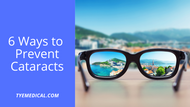6 Ways to Prevent Cataracts
Written by TYE Medical on Apr 25th 2023
It’s possible to prevent cataracts or delay their development. Awareness and maintaining eye health is key. And while you probably realize that cataracts affect your vision, you might not understand exactly what they are or why people develop them.
Your eye lens covers the front of your eye and is both curved and clear. It helps you focus your eyes at different distances much like the lens of a camera. But cataracts are the cloudy areas that form over your lens.
Your age is your biggest risk factor for cataract formation. Over half of Americans age 80 and older either have cataracts or have had cataract surgery. As a larger portion of our population ages, the number of cataract cases will rise sharply.
But there are preventative steps you can take to be proactive about eye health and minimize your cataract risk. Here are 6 ways to prevent cataracts.
1. Sun Protection

This is probably the most well-known means of prevention. The sun’s ultraviolet (UV) light damages your eyes and unleashes damaging molecules (free radicals) that affect proteins in your lens, making them clump together.
If you’re someone with higher levels of sun exposure throughout your lifetime, your risk of developing cataracts is greater. But protecting your eyes from the sun’s harsh effects can be as simple as wearing sunglasses and a brimmed hat while you’re exposed to UV. Your best eye protection will be sunglasses that provide 100% UV protection from both UVA and UVB rays.
2. Stop Smoking
The chemicals in cigarettes can also disrupt proteins in your eye lens and cause clumping that form cataracts. If you smoke, your risk of forming cataracts is two to three times higher for nonsmokers.
But smoking causes more than just cataracts, it can lead to a form of eye damage known as macular degeneration. This condition affects your retina and can lead to vision loss.
For general health and eye health, stopping smoking can decrease your risk of several diseases and conditions.
3. Eat a Nutritious Diet

A healthy and balanced diet provides the nutrients and antioxidants necessary to protect your eyes from damage and prevent cataracts. Generally, it’s believed that getting these nutrients directly from food is more effective and beneficial than getting them from supplements.
This means your diet should be rich in fruits, vegetables, and minimally processed foods. Eating foods in less processed, whole-food form allows you to derive more nutrients. And while it’s considered most effective to get your nutrients from foods, some antioxidants like vitamin C and E can be helpful in small or moderate doses.
If you want the lowest risk of cataracts, ensure you get plenty of these in your diet:
- Fruits and vegetables
- Multivitamins
- Vitamin C
- Zeaxanthin
- Lutein
Both Zeaxanthin and Lutein are antioxidant molecules found in your eyes. They are also contained in foods like:
- Spinach
- Pistachios
- Green peas
- Romaine lettuce
- Summer squash
- Brussel sprouts
- Broccoli
- Pumpkin
- Asparagus
- Carrots
Other than providing protective antioxidants a healthy and nutritious diet also helps prevent type 2 diabetes. Your cataract risk is up to five times greater with diabetes.
4. Protect Against Eye Injuries
Trauma to your eye can cause lens ruptures or other types of damage. This leads to a clouded lens and impaired vision. It is typically referred to as a traumatic cataract. Of course, you can prevent damage when you use appropriate eye protection during sports or other activities.
Helpful safety wear like helmets, goggles, and safety glasses can protect your eyes during contact sports, use of chemicals or projectiles, or the use of power tools.
5. Drink Less Alcohol

Your cataract risk increases with higher lifetime drinking levels. Research suggests specifically that more than 90 drinks per year for men and 40 drinks per year for women created a significant risk of cataracts. And as with smoking, when you stop drinking alcohol or reduce your intake, you’ll experience other health benefits too.
6. Get Routine Eye Exams
As with most preventative care, it can help you detect a problem before it’s a problem (or before symptoms are noticeable). Routine eye exams can help you identify cataracts in the early stages before they significantly affect your vision. And this is also true of any eye disease that an exam detects in its early stages. This helps to lower the risk of developing eye diseases that risk more serious complications.
While you probably realize that for general health, you should see a primary care doctor annually. But you might not realize how often you need a preventative eye exam.
If you have a low risk for developing an eye disease, the American Academy of Ophthalmology gives the following recommendations for comprehensive eye exams:
- Ages 40-54–every 2 to 4 years
- Ages 55 to 64–every 1 to 3 years
- Ages 65 and older–every 1 to 2 years
- Any age with diabetes–every year
Even if you don’t have symptoms but are at higher risk for developing an eye disease, you might need to have more frequent eye exams.
Cataract Prevention Recap

You can’t guarantee complete prevention of cataracts. It takes a lifetime of eye care and protection. Genetic factors also play a role. But you can take several simple steps toward reducing your risk of cataracts while also promoting overall eye health.
If you’re still concerned about your eye health, talk with your doctor about additional recommendations and preventative steps. It’s not uncommon to require cataract surgery to replace the damaged lenses. For more information, check out our article, What to Expect During Cataract Surgery Recovery.


